AI-based malware detection in IoT networks within smart cities: A survey
IF 4.5
3区 计算机科学
Q1 COMPUTER SCIENCE, INFORMATION SYSTEMS
引用次数: 0
Abstract
The exponential expansion of Internet of Things (IoT) applications in smart cities has significantly pushed smart city development forward. Intelligent applications have the potential to enhance systems' efficiency, service quality, and overall performance. Smart cities, intelligent transportation networks, and other influential infrastructure are the main targets of cyberattacks. These attacks have the potential to undercut the security of important government, commercial, and personal information, placing privacy and confidentiality at risk. Multiple scientific studies indicate that Smart City cyberattacks can result in millions of euros in financial losses due to data compromise and loss. The importance of anomaly detection rests in its ability to identify and analyze illegitimacy within IoT data. Unprotected, infected, or suspicious devices may be unsafe for intrusion attacks, which have the potential to enter several machines within a network. This interferes with the network's provision of customer service in terms of privacy and safety. The objective of this study is to assess procedures for detecting malware in the IoT using artificial intelligence (AI) approaches. To identify and prevent threats and malicious programs, current methodologies use AI algorithms such as support vector machines, decision trees, and deep neural networks. We explore existing studies that propose several methods to address malware in IoT using AI approaches. Finally, the survey highlights current issues in this context, including the accuracy of detection and the cost of security concerns in terms of detection performance and energy consumption.
智慧城市物联网网络中基于人工智能的恶意软件检测:一项调查
物联网在智慧城市中的应用呈指数级增长,极大地推动了智慧城市的发展。智能应用程序具有提高系统效率、服务质量和整体性能的潜力。智慧城市、智能交通网络和其他有影响力的基础设施是网络攻击的主要目标。这些攻击有可能削弱重要的政府、商业和个人信息的安全性,将隐私和机密性置于危险之中。多项科学研究表明,由于数据泄露和丢失,智能城市网络攻击可能导致数百万欧元的经济损失。异常检测的重要性在于它能够识别和分析物联网数据中的非法行为。未受保护的、受感染的或可疑的设备对于入侵攻击可能是不安全的,入侵攻击有可能进入网络中的几台机器。这干扰了网络在隐私和安全方面提供的客户服务。本研究的目的是评估使用人工智能(AI)方法检测物联网中恶意软件的程序。为了识别和预防威胁和恶意程序,目前的方法使用人工智能算法,如支持向量机、决策树和深度神经网络。我们探索了现有的研究,这些研究提出了几种使用人工智能方法来解决物联网中的恶意软件的方法。最后,调查强调了在此背景下的当前问题,包括检测的准确性和检测性能和能源消耗方面的安全问题成本。
本文章由计算机程序翻译,如有差异,请以英文原文为准。
求助全文
约1分钟内获得全文
求助全文
来源期刊

Computer Communications
工程技术-电信学
CiteScore
14.10
自引率
5.00%
发文量
397
审稿时长
66 days
期刊介绍:
Computer and Communications networks are key infrastructures of the information society with high socio-economic value as they contribute to the correct operations of many critical services (from healthcare to finance and transportation). Internet is the core of today''s computer-communication infrastructures. This has transformed the Internet, from a robust network for data transfer between computers, to a global, content-rich, communication and information system where contents are increasingly generated by the users, and distributed according to human social relations. Next-generation network technologies, architectures and protocols are therefore required to overcome the limitations of the legacy Internet and add new capabilities and services. The future Internet should be ubiquitous, secure, resilient, and closer to human communication paradigms.
Computer Communications is a peer-reviewed international journal that publishes high-quality scientific articles (both theory and practice) and survey papers covering all aspects of future computer communication networks (on all layers, except the physical layer), with a special attention to the evolution of the Internet architecture, protocols, services, and applications.
 求助内容:
求助内容: 应助结果提醒方式:
应助结果提醒方式:


